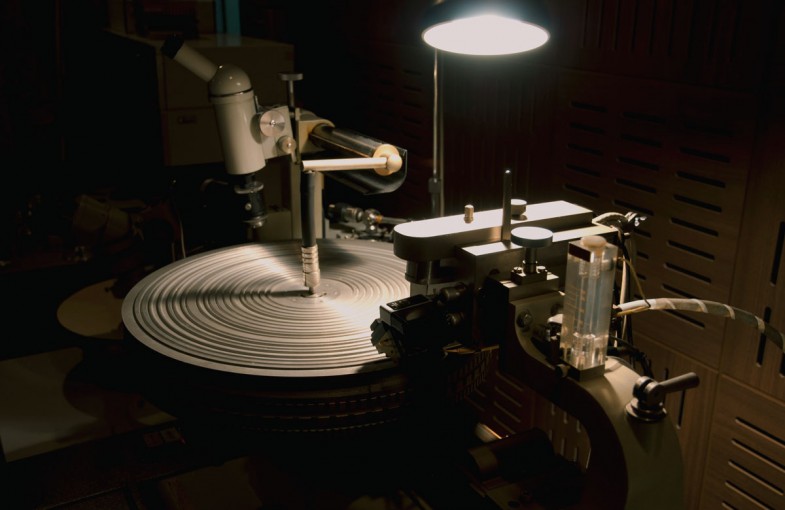The nations largest record manufacturer, United Record Pressing, announced an increase in capacity thanks to the resurgence in demand for vinyl. Bearing this in mind, it’s a great time to discuss what makes a quality record. Even if you don’t obsess over the nuances of sound reproduction and records are more of a passing hobby, knowing the importance of vinyl composition and manufacturing processes illuminates the details of analog technology.
The Process
A good record begins with 100% pure, virgin vinyl. That means the raw product is new, not previously part of another disc or combined with recycled vinyl in any ratio (70% new/30% recycled is common). Secondly, since records are a form of analog technology, their source material should be of an analog format as well – usually tape – and then mastered by someone like Kevin Gray. From there, the lacquer(s) (which are cut on a lathe during mastering) go through a three step electroplating process which first generates a Matrix (negative) then a Mother (positive) and lastly Stampers (the negatives used to press the grooves into a record). Combine it all with labels, a sleeve, jacket, some hype stickers and ship it off to distributors and we, the customers around the world, buy it hoping the hard work pays off.
Departures from the above prescription are common because musicians like to alter the physical appearance of their albums to match a theme carried throughout the music and artwork or sometimes just to be different. United offers plenty of choice here with a few dozen color recipes for recommended combinations. Custom color options are the center of a debate among listeners, musicians and engineers that claim colored wax sounds different than a standard black pressing. It may be that the process of adding a colorant to the raw material negatively affects sound reproduction, but definitive evidence is hard to come by so personal preference is the best opinion to take. I prefer high-quality standard pressings with no frills, but then again, if a limited edition is available I often buy both.

This record stamper is fitted to a press along with it’s mate to form the A and B side of a record.
Masters Matter
Analog masters are critical but according to United’s FAQ’s, most of their customers deliver audio on CD’s. That means the source material for the pressing is actually a digital master (not necessarily compressed, but still digital). It may not matter though, since the industry quickly adopted digital technology as it became available and advances are regularly improving sound performance. Debates continue and sources have different opinions that allow readers to make up their own mind after discussing the facts. I prefer to know as much as possible about a release before I purchase a copy. Few artists disclose that information, so it becomes an educated guess based on past experience with specific labels and musicians in respect to the quality of the end product.
Unfortunately, supplying analog masters does not guarantee a truly analog production workflow making this all a bit murky. The process requires more of an investment in time, people and equipment making it difficult to justify in the face of modern technology. High-resolution digital sources continues to trend upward and the results among listeners are generally positive. Basically, a high-resolution digital source consists of a lossless audio codec capturing sonic information at an increased bit depth. The product reproduces sound among a larger number of frequencies than that of an mp3, the long-time standard of the iPod generation. Experiencing the difference requires spending a little bit more than the average new record purchase. Quality Record Productions (QRP) in Salina, Kansas, specializes in manufacturing premium, audiophile pressings in addition to standard releases from thousands of labels worldwide. The price point of records on the Analogue Productions label begin at $30 and move up from there. Your ears will have to decide if the quality justifies the extra cost.
Packaging
Packaging has a two-fold purpose: to look good and protect what’s inside. With each record coming off the production line, consideration has to be taken into what and how they are housed. Bulk shipping to disturbers and customers via Media Mail offers affordability but not necessarily the security of a package’s contents. All kinds of damage can happen from scuffing, scratches and fractures contributing to a poor – or perhaps impossible – listening experience once the item reaches a consumer. The hated bleached white paper sleeves might be the worst thing for a freshly pressed record short of dropping it on the floor. Upgraded sleeve are appreciated but again, it’s an up-sell that pressing plants charge for. That extra cost is passed onto the consumer but I’m fine with that so long as the money contributes to a decision that means the record will look good and sound excellent.
Choose Wisely
This entire process comes together like a puzzle. When pieces are missing, the puzzle is incomplete or at best results in a subpar listening experience. On top of that, not all records are created equal so why spend money on something that may actually be of inferior sonic quality to a CD or a high-resolution digital file. Admittedly, collecting records is rarely just about the sound; it’s about the experience of looking for years to find a rare album and the simple pleasures of ownership. Remember what a record is and how vinyl is susceptible to problems from both a production and listening standpoints. Imperfections bring music to life and to escape them completely would eliminate the humanistic element often cited as the most enjoyed attribute missing from digital HiFi.
Feature Image under CC License from Wikipedia
Valuable Wax – Record Store Day 2014 Next Post:
Cataloguing Records with Discogs






















[…] analog recording technology. Reprinted with permission from Matt’s site Wax Times, where the original post first […]
[…] analog recording technology. Reprinted with permission from Matt’s site Wax Times, where the original post first […]
[…] analog recording technology. Reprinted with permission from Matt’s site Wax Times, where the original post first […]
[…] analog recording technology. Reprinted with permission from Matt’s site Wax Times, where the original post first […]
[…] Pressing Issues: Record Quality in Today’s Market Some good advice to keep in mind when buying vinyl. […]